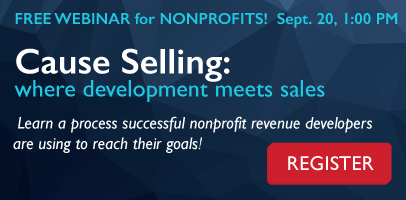
Developing revenue for nonprofit organizations can be a challenge for many reasons. One of the main reasons is finding potential donors and sponsors who resemble your best partners and meet the following criteria:
1. Dollar Potential
Would the prospect be able to invest and contribute a significant amount of money if they were motivated to do so? This is quite purposely not the same as asking if they support your cause or similar causes. You want to know if they have enough money to invest at a significant level and worthy of your time.
2. Access & Credibility
Can you gain access to the decision maker, key decision influencers, or the major donor? Do you have or can you gain credibility in their eyes? In some organizations and with some people, it’s virtually impossible to get the access and credibility you need. In others, whether they be a partner or donor, it’s a breeze (but they may not have the best development potential). Among the best prospects, the question usually comes down to: What must I do in order to gain access and establish my credibility and am I willing to do it?
3. Mission Fit
Is it likely they have needs that match-up with your organization’s mission? How closely matched is your donor base to their consumer base?
4. Value-added Fit
The other kind of fit is just as important. From what you can tell, will they value the things you bring beyond access to your constituency? Will they invest more for the things—idea development and ROI concern—you do better than other nonprofits?
5. Leverage
If you were successful in converting this prospect, would it open the door to lots of other opportunities for you? Could you ‘leverage’ that success into other successes? Could it be a source of referrals and recommendations? Could it lead to business from other departments or divisions of the same organization? Would successful dealings with this prospect put you on a fast learning curve so that you’d be better able to handle a similar prospect?
6. You Personal Reasons and Your Personal Feelings
What factors create the ideal client for you personally? Think about personality, values, work style, types of needs to be filled, industry preferences, specialized knowledge and experience. Your personal conviction about targeting this prospect is an important factor in improving your chances of success.
Here are some tips to follow to find potential donors and sponsors who fit this ideal client profile:
- Many companies have community related initiatives. Find out if your prospect has a department or person in charge of community relations by Google searching, “COMPANY NAME community relations” or search for community relations titles on LinkedIn.
- There are many employer benefits for companies who choose to partner with a local nonprofit in the community in which their employees live, so find a list of all corporations headquartered in your city or within a defined mile radius of your city. Choose a few companies that interest you and Google search them to see what you can find out.
- Cause marketing truly works best when it comes from the heart. If your prospect(s) tends to volunteer in their spare time, such as coaching youth sports or spending personal time helping with social causes, they may be more likely to listen to ideas involving cause marketing. To do this, try scrolling down their LinkedIn profile and see if they list any volunteering.
- The Millennial demographic has become very important to many categories of business. Keeping in mind that a Millennial will engage sooner and more often with brands that support a nonprofit, cause marketing may be a great addition to an overall marketing strategy for brands that need to engage and earn the trust and loyalty of Millennials.
- Does a prospect have a new product roll out or new store opening? If so, a cause marketing campaign will increase the likelihood of a consumer’s willingness to make a change and try something new.
Chasing suspects who don’t have money to support your cause or are not aligned with your mission can be a frustrating process for nonprofit development officers. How do your prospects stack up to the items listed above? Take a few moments to evaluate the organizations you are currently pursuing. Investing time upfront and selecting better prospects will save time and resources in the long run!
To learn more about the ideal client profile, register for the Cause Selling webinar. You’ll learn the following:
- Ways to set more face-to-face appointments
- Understanding donor needs
- The types of questions to ask to uncover needs
- Plus much more!



